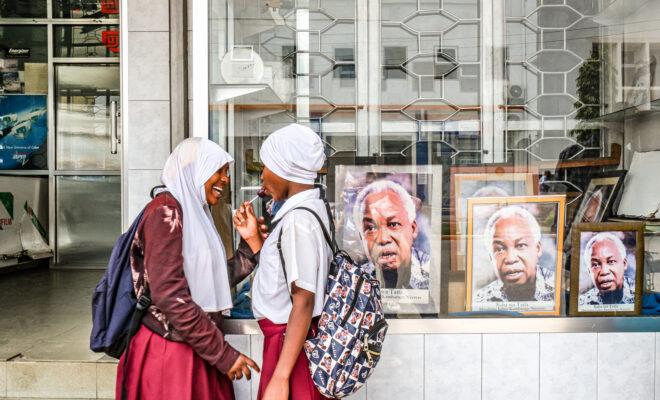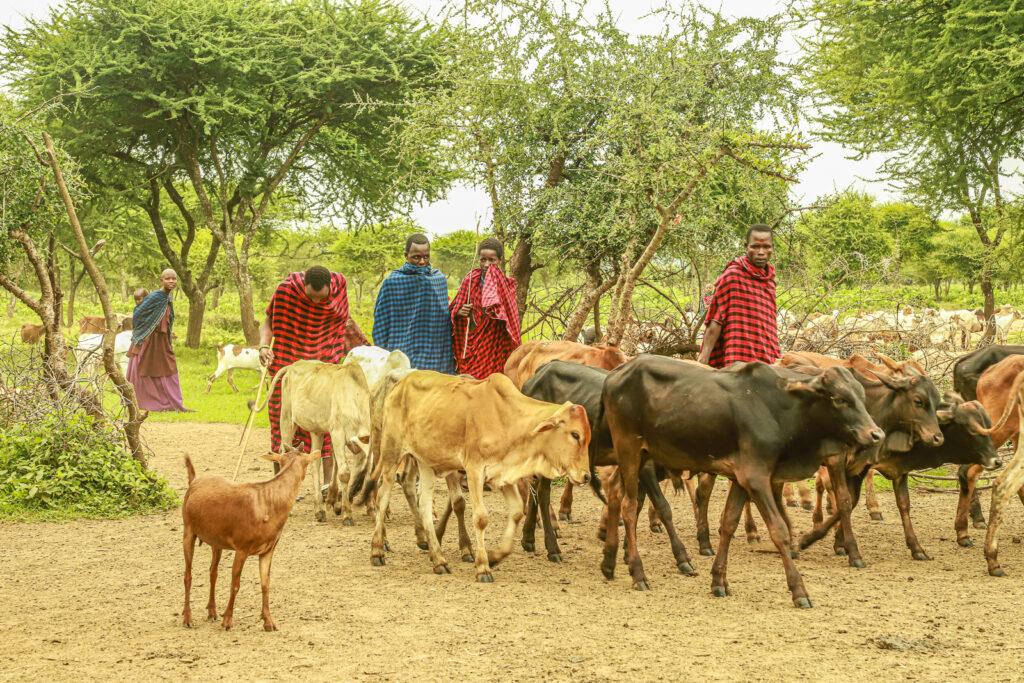Tanzania: Remembering ujamaa, the good, the bad and the buried

Julius Nyerere and his African socialist policies are regarded with great pride in Tanzania, but not by all who experienced them first-hand.

Two school girls stand outside a shop in Arusha, Tanzania, with framed photos of Julius Nyerere displayed. Credit: Jaclynn Ashly.
Ali Hassan Mohammad was just 20 years old when Julius Nyerere, Tanzania’s first president, spearheaded a nationwide re-organising of rural society called ujamaa. Meaning “familyhood” in Swahili, the term is often translated as “African socialism”.
“It was a hopeful time. Nyerere was bringing people together and uniting us,” says Mohammad, now 76, from his dimly lit kitchen in the northern city of Arusha. “We are still very friendly people and cooperating with one another. A lot of that is because of Nyerere. He united all of us under one national identity.”
Mohammad’s perspective on ujamaa is a typical one in Tanzania. Nyerere is endearingly referred to here as mwalimu (“teacher”) or baba wa taifa (“father of the nation”). He is credited with unifying the country and pushing development through ambitious socialist policies that followed decades of colonial rule – first by the Germans and then the British. These plans were mapped out in the 1967 Arusha Declaration, in which Nyerere paints a picture of a utopian society based on egalitarianism. He imagines a self-reliant country in which hard work within a cooperative framework ensures human equality and dignity.
The crux of this daring transformation was villagisation – or ujamaa vijijini (“rural socialism”). With a population dispersed over a vast landscape and rural areas still severely underdeveloped, Nyerere envisioned collecting farmers into cooperative agricultural settlements. These ujamaa villages would then be provided with equipment along with fertiliser and seeds. This would facilitate agricultural production, while making it easier for the government to distribute state services such as education and healthcare. Nyerere explained that these villages would be “a voluntary association of people who decide of their own free will to live together and work together for their common good”.
“Nyerere made it so we were all living together in peace,” declares Mohammad. “There was development under Nyerere, and this is what Tanzania needed.”
He says this with pride beaming from his face in much the way many politicians, academics and activists speak of ujamaa both in Tanzania and around the world. They celebrate Nyerere’s policies for uniting a large country of more than 100 ethnicities into a cohesive postcolonial state.
However, not all Tanzanians share this perspective. Some who lived through this era tell a very different story – one riddled with imprisonment without charge or trial, enforced disappearances, and destroyed livelihoods.

Ali Hassan Mohammad.
Nyerere promised to establish a new economic order based on traditional African communal values. He argued that Tanzania did not need to borrow ideas from Marx or Lenin because the culture of socialism – defined as hospitality, cooperation and hard work – was already a staple of societies throughout Africa.
“In our traditional African society we were individuals within a community. We took care of the community, and the community took care of us. We neither needed nor wished to exploit our fellow men,” Nyerere wrote in Ujamaa: Essays on Socialism. He argued that these core African values just needed to be strengthened and built. For him, that meant villagisation along with the nationalisation of banks, farms and industries.
To be considered an ujamaa village, an agricultural settlement had to consist of at least 250 households, with each house adhering to specific measurements. Every family, regardless of size, was allocated a maximum of one or two acres of land.
Mohammad did not live in one of these villages as he was a lieutenant in the Tanzania army at the time, but he looked on them admiringly. “In the ujamaa villages they owned their land, and they had nice houses,” he says.
Yet relatively few of his compatriots were as convinced. Despite Nyerere’s powerful rhetoric, just over half a million people – less than 5% of the mainland population – had volunteered to live in an ujamaa village by 1970, according to Ugandan scholar Mahmoud Mamdani.
This lack of excitement did not match Nyerere’s grandiose vision. Therefore, in 1972 the ruling Tanganyika African National Union (TANU) introduced compulsory relocations with the aim that the whole of Tanzania’s rural population would be in ujamaa villages by the end of 1976.
According to James C Scott, author of Seeing Like a State: How Certain Schemes to Improve the Human Condition Have Failed, at least five million Tanzanians were forcibly relocated in what “by most accounts was the largest forced resettlement scheme undertaken in independent Africa up to that time”. Others have estimated that 80-90% of the rural Tanzanian population was moved into ujamaa villages.
This came at a significant price. Homes and entire villages were burned to the ground as people were ushered into agricultural collectives, which oftentimes lacked adequate planning and sanitation.
According to Mamdani, compulsion also had a “catastrophic economic consequence”. He noted in Define and Rule: Native as Political Identity that Tanzania went from exporting 540,000 tons of surplus maize in 1970 to importing 300,000 tons of maize in 1974. Between 1970 and 1975, total per capita food production fell to its 1960 level.
Despite the destruction that shaped this era, Mamdani argues that Nyerere’s state-building project of ujamaa was “the most successful [post-colonial] attempt to dismantle the structures of indirect rule”. Many other scholars agree.

Lesira Samburi in his village of Terat in Simanjiro.
For some Tanzanians who were on the receiving end of these policies, however, indignation still runs deep. Lesira Samburi, 67, is a leader in the semi-pastoralist Maasai community from the village of Terat in the Simanjiro district. “As pastoralists, we were not happy under ujamaa,” he says. “At the time, the government forced us from our lands and made us settle together. They came and burned our bomas [homesteads].”
Samburi sits on a green plastic chair next to his traditional home – constructed of cow dung, mud, wood and cowhide – and offers tea mixed with milk to other Maasai who have gathered to listen.
“At the time, we didn’t know why they were doing this,” he continues. Samburi says that the Maasai, who were scattered across a vast region of land in northern Tanzania, did not own radios at the time. “Even when Tanzania got its independence, it took a very long time for us to hear about it. We found out maybe a year later,” he chuckles. “We heard from our leaders about this person called Nyerere, but we didn’t think much of it. We were busy caring for our cattle.”
Samburi explains that the community was initially dismayed at the ujamaa policies but gradually saw the benefits. “We were really angry at the government’s policies at the time. But, in the end, most of us realised that when we are together, we are provided better services.”

Young Maasai men and boys herding cattle through Lesira Samburi’s boma.
Tanzania’s forced relocations came on the heels of TANU – which merged with the Zanzibar-based Afro-Shirazi Party (ASP) in 1977 to become Chama cha Mapinduzi (CCM) – consolidating its power to create a centralised one-party state. Nyerere believed that this was necessary to build national unity and avoid political divisions.
Opposition parties were banned. Public dissent was at times met with enforced disappearances and prison without charge or trial. There was little room for Tanzanians angry over Nyerere’s policies to protest. But that did not stop some, like Agostino Lissu Mughwai, from resisting.
Mughwai’s son is Tundu Lissu, the presidential candidate for the main opposition Chama cha Demokrasia na Maendeleo (Chadema) in the October 2020 elections. The 52-year-old returned to Tanzania in July for the first time since 2017 when unidentified assailants shot him numerous times in an assassination attempt. He was forced into exile once again following the disputed elections, which led to violence and hundreds of opposition members being arrested or abducted.
“Those who say [ujamaa] was a good thing were those who did not experience it,” says Lissu, who describes himself as “a child of villagisation”. He was just six at the time but says he remembers everything. “These are the kinds of memories that will remain with you forever,” he adds.
Lissu says that in 1974, the Tanzanian government was preparing to destroy and relocate his village of Mahambe in the Ikungi district to an area “in the middle of the forest”. His father, Mughwai, was a civil servant working in the local administration and caught wind of the scheme.
According to Lissu, the area in the forest was barren and the government would not develop it, leaving people to build homes themselves. “My father and uncle called the villagers together and told them the government’s plans,” Lissu explains.
Several village elders, including Mughwai and his brother Edward Bulali, travelled to Dar es Salaam to voice their protests. “Phone calls were made and the decision to move the village was rescinded,” explains Lissu. “Those people making these decisions had never even been to the village. People were just making decisions on a piece of paper.”
This episode, however, caught the attention of local bureaucrats. They wondered “who these bloody villagers were who were pulling strings in Dar es Salaam”, says Lissu. “Our village is very small, but it has always been one of those places that punch way above its weight.”
Mughwai became a target. Local authorities demoted him and tried to transfer him to a faraway posting. “The next day he went with a resignation letter. He never even got his pension. He lost everything,” says Lissu.
But the village’s reprieve was short-lived. Later the same year, government officials declared that Mahambe would be destroyed as it was too small for an ujamaa village. The villagers mobilised again. They knew smaller nearby villages would have to be flattened too, so pulled strings to get those settlements demolished first and their people added to Mahambe.
The village was therefore able to make the 250-household requirement but once again there was a problem. The houses were too scattered and did not conform to the measurements mandated by ujamaa. “My father this time didn’t have the answer and so the houses were demolished. They destroyed everything and left,” laments Lissu. In the following weeks, the villagers rebuilt the entire village – making sure all the houses were in a straight line and fulfilled the requirements – without any government support.
“The years of ujamaa were the years of constant shortages,” continues Lissu. “They would bring a carton of soap, which had 20 bars containing five pieces, every month. They would bring 50kg of sugar for one month. How do you ration 50kg of sugar in a village of more than a thousand people? We had shortages of everything, including food. And this had a lot to do with ujamaa.”

Tundu Lissu. This portrait was taken during my visit to Belgium in February 2020, before he returned to Tanzania to run for president.
According to Ludovick S Mwijage, 69, many Tanzanians had the same experience. “There was hunger all over,” he says. Mwijage is the author of Julius K Nyerere: Servant of God or Untarnished Tyrant? He was arrested twice by Nyerere’s regime and spent almost two years in prison without charge or trial. In 1985, he fled to Rwanda and eventually became a refugee in Denmark.
Before that, Mwijage had stayed in an ujamaa village for about a month in the northern Monduli district. “People were being forced into these villages like cattle,” he says. “They had no option. They were being forced to do something they didn’t believe in.”
Mwijage recalls distributing food aid from the US to residents in surrounding ujamaa villages. “If it was not for foreign aid, Tanzania would have collapsed like Somalia. This was the ultimate result of relocating people and herding them into collectives,” he says. “If this was really about providing services and infrastructure, then they would have constructed the villages, set up the infrastructure and then encouraged people to live there. In Tanzanian society, we were always cooperating and assisting each other. We didn’t need a police officer with an AK-47 standing to the side and watching over us.
“This had nothing to do with socialism. It was about political control. Nyerere was a bully, and he was worse than a colonialist.”
Lissu echoes this sentiment, arguing that Nyerere and other postcolonial African leaders’ ideologies were inspired more by colonialists than Mao or Stalin. “The colonial state itself was very authoritarian and repressive,” he says. “What we have has been a continuation of this colonial state. At independence, instead of changing this they [African leaders] actually consolidated it by giving it a nationalistic colouring. These same repressive [colonial] policies then became an instrument of development.”
Lissu also sees parallels with Tanzania’s current president. Since taking office in 2015, President John Magufuli has been criticised for human rights violations and the erosion of democratic freedoms. Under his watch, freedoms of speech and the press have been curtailed and his opponents have been arrested, threatened and harassed. In the October elections, the government was accused of widespread electoral fraud as Magufuli won in a landslide over Lissu and the ruling CCM won 98% of parliamentary seats.
“The argument continues to be that we are a poor country that needs to develop quickly, and we cannot put ourselves in constitutional straitjackets,” says Lissu. “But it’s these developmentalist ideologies that are used to cover up dictatorships.”
Nyerere, however, stepped down in 1985 and allowed Tanzania’s politics and economy to liberalise after seeing the shortcomings of one-party rule and ujamaa. In the 1990s, multi-party democracy was introduced, but Lissu warns that Magufuli has now pulled Tanzania back to the “dark ages” of one-party rule.
Nyerere’s legacy is one that encapsulates heroism and pride for some and stokes anger and resentment in others. According to Lissu, both sides of Nyerere’s conflicting legacy are equally important in understanding Tanzania’s history.
Yet it remains taboo to criticise Nyerere in Tanzania’s public spaces. His framed photograph is firmly fixed to the walls of banks, offices and inside all government buildings. Nyerere is a powerful symbol of national pride.
Lissu, who has a reputation of being one of Tanzania’s most outspoken politicians, says he has criticised Nyerere in a “very public way”, which “makes people very uncomfortable”.
“Nyerere is our secular saint. People love to have something they can hold onto,” he says. “If you knock Nyerere off of the pedestal, then what do we have left? So we have to build up all of these lies around his image. But my position is that we need to humanise Nyerere. And to humanise him is not to disrespect him. It’s to acknowledge that he was a human being. And he was a politician and did things that politicians do – like arrest and kill people.”





Jaclynn Ashly, thanks for this. I have noted, you have choosen that side of the story, Ujamaa, had the good, the bad and the ugly depending, on which side you will write about Ujamaa.